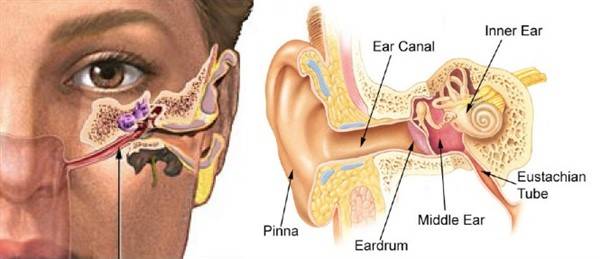Though the monsoon brings us the much-needed respite from the summer. It also comes with its own set of problems. The increase in waterborne diseases and the high humidity is bad for people who suffer from throat and ear infection.
Read on to know how to prevent Ear infection or Otitis media, which is the infection of the middle ear during the humid weather. Stay infection free and enjoy the rains. One has to take special care of children. Ear infection in babies is very common as they are vulnerable due to their low immunity.
Why Do We Get Ear infection during Monsoon?
The increase in humidity due to the rains is an ideal condition for fungus and bacteria to grow. We often get caught in the rain and get drenched. Not changing into dry clothes immediately or walking into an air-conditioned room in wet clothes is an invitation for common cold and throat infection. According to ENT Doctors, the increase in ear infection cases jump 6 to 10 times during monsoons.
What are the Types of Ear Infection during Monsoon?
There are 2 types of Infections which are common during monsoon.
1. Bacterial Infection
Though bacterial infection cases occur throughout the year, there is a large increase in cases during monsoon.
2.Fungal Infection
Fungal infection occurs when the humidity is high. The wet and moist surfaces are breeding ground for fungus. The infection lies in the outer ear or the ear canal. The scientific name for fungal infection is Otomycosis. Read our article on fungal ear infection for more information.
What Are The Causes of Bacterial Ear Infection?
Bacterial infection can happen due to several causes. Throat infection is very common during the monsoon. Normally the infection during monsoon starts from the throat. Smokers are more prone than others. Most of us do not pay attention and expect the infection to cure on its own. This infection spreads to the ear through the Eustachian tube.
Eustachian Tube Infection

Being exposed to rain, snow and cold wind may lead to a throat infection. The infection in the throat spreads to the Eustachian tube, this tube connects the throat to our Ear. The ear gets infected through the Eustachian tube. This infection is caused by bacteria.
Symptoms Of Bacterial Infection
- A slight ache or discomfort in the ear is the first sign. Our ears do not ache unless there is something seriously wrong.
- A feeling of fullness or stuffiness in the ear. The feeling is due to the increase in pressure.
- Hearing loss is another sign of Otitis media. This Hearing loss is temporary, the hearing returns to normal once the infection is treated and cured.
- Discharge from the ear. Discharge from the ear indicates the formation of pus and requires immediate attention.
Important Tips To Prevent Bacterial Ear Infection During Monsoon
The middle ear gets affected by bacterial infection as it spreads from the throat. We should protect our throat to ensure that the infection does not spread to the Ear.
- During the rains, it is advisable to avoid cold drinks and foods which irritate the throat. Have lots of hot liquids like Tea, Coffee and Soups.
- Gargle your throat with salt water, salt water is a safe disinfectant.
- Carry a hand Sanitizer at all times, use Sanitizer if your hands come in contact with surfaces touched by others. For e.g. door knobs, bus and metro handrails.
- If an infection has already set in, antibiotic treatment may be needed. Consult the doctor immediately, timely treatment will prevent the spread of infection.
What Are The Causes Of Fungal Ear Infection?
Fungal infection is generally caused when the fungus is formed in the ear. The 2 main reasons are-
- Transfer Of Fungus From An External Source To Our Ears.
During the humid weather, fungus tends to grow on surfaces or clothes which are exposed to dampness. Touching fungus infected clothes or surface transfers the fungus to our hands. At times we insert the same fingers into our ears. This transfers the fungus to our ears.
- Allowing Fungus To Grow In The Ears.
While most of the cases of fungal infection spread from external sources. The fungus can also develop in the ear. Earwax and dead skin in the ear canal supported by the humid weather can cause fungal infection.
Symptoms of Fungal Ear Infection
- The outer ear becomes red and starts itching.
- Swelling of the ear.
- The skin on the ear becomes dry and starts scaling or peeling off.
- In extreme cases, pus formation is noticed.
Tips To Prevent Fungal Infections During Monsoon

- Keep your ears clean and dry.
- In case your ears itch, avoid using cotton ear tips or your fingers unless they are clean.
- Check for earwax. Clean your ears regularly. Though it is always advisable to visit the Doctor, earwax can be cleaned at home.
- After a shower, dry your ears with a clean dry cloth.
- If you use headphones or Bluetooth to listen to music, use a disinfectant to clean the earpiece regularly.
- Use a hand sanitiser or wash your hands with an antiseptic soap.
- Avoid swimming or getting your wet till the infection is totally cured.
Timely Precautions to Prevent Ear Infection
Fungal ear infection is usually in the outer ear. It is necessary to visit your Doctor, the treatment is very simple. The Doctor will clean your ears to remove the fungal growth and prescribe anti fungal ear drops. Delay in treatment can cause complications requiring hospitalization.
Ear Health should be a very important part of our daily hygiene. Keeping the ears dry and clean can help avoid unnecessary infections and absenteeism from work. We should ensure that our children’s ear are clean and dry to avoid infection and absenteeism at school.
